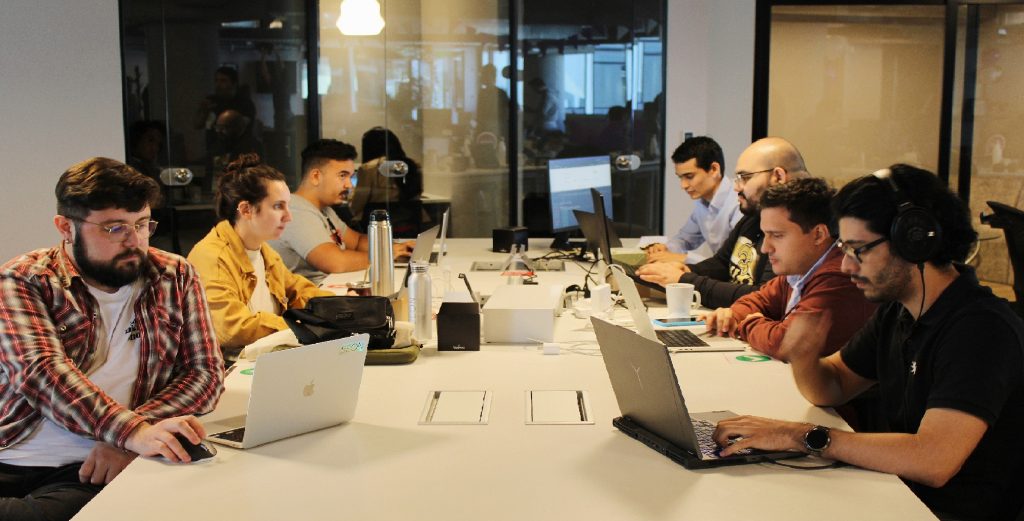
Building an agile software development team is challenging. Timelines are always pressing, yet you need to find professionals with the right technical and cultural fit for your company. These partners will be a part of your universe daily during the project, so you want to make the right choice.
Because of this, many seek to take these issues off their plate with the help of development partner that offers them nearshore agile software development services, whether it is through staff augmentation or dedicated teams.
What do these services consist of, and how can someone choose the right one? We will review the answers to these questions below.
What are nearshore agile software development services?

Nearshore agile development services consist of a wide variety of works performed by the professionals within a company which are oriented towards producing, maintaining, or redesigning one or multiple software products or tools to meet client needs.
These services are performed following the agile methodology, which is a set of practices that seeks the continuous delivery of working software created in rapid iterations.
The word nearshore implies that the company performing the services is in geographical proximity with the client and, thus, in similar time zones. Nearshore outsourcing allows you to collaborate in real time and saves you from having to push project work to odd hours.
What is the difference between nearshore and offshore agile software development?

Nearshore and offshore agile software development are often confused, and some people use them interchangeably, but these terms are a world apart, literally.
In nearshore software development, the agile software development services are carried out by a company within the same geographical zone as the client needing service. The same geographical zone means that the company is in a country that is in the same continent as the client’s.
In contrast, offshore means that the company providing the services is overseas and, thus, working in a different time zone and within great distance of the client.
What are the advantages of nearshore agile software development?

Communication: One of the most critical things in software development projects is communication. Being able to discuss the process with our clients daily is mandatory. But effective communication requires both parties to be working during the same hours.
For clients, having the dev team in a different time zone can make the communication process more challenging. Differing cultural backgrounds or traditions can bring even more misunderstandings, leading to wasted time or money.
Quality: Concluding there is a place where there are better professionals than others would be wrong. There are high-performing professionals everywhere. However, it’s important to mention that tech and sciences are strongly grounded in the education systems of many countries in Latin America, creating professionals that deliver high quality code not for money, but because it’s their passion. These factors make this continent home to a Sillicon Valley-compatible talent pool.
Cost: Software development talent pool costs in South and Central America are lower than those in the U.S. However, they’re a bit higher than fees charged by developers in Eastern Europe and considerably more than those charged in India.
Why does Latin America have an edge?

Eastern Europe (GMT+2) and India (GMT+5:30) are 10 and 13.5 hours, respectively, ahead of the Pacific time zone in the United States.
Now, imagine you’re the CTO of a recognized ecommerce site in Santa Monica. Your team from Delhi DMs you about an issue — the checkout flow is calculating prepaid discounts wrong. In other words, you’re giving your money away to all prepaid customers. Facebook ads are currently running at a cost of $3K-$5K per day.
1:00 PM in Santa Monica / 2:00 AM in Delhi. At 3 pm you write an email to your project manager in Kyiv but — as it’s 1 am there — the dev team is unavailable.
10:00 PM in Santa Monica / 11:00 AM in Delhi. You are left with no options but to wait until they get to the office. At 8 am in Ukraine, your engineer looks into it, works on a fix, and finally pushes it to production at 8:30 am.
His project manager approves the change, and the fix needs your final approval. But, at the time, you are unavailable and they can’t wait, so they make the decision of doing it without your approval.
7:00 AM in Santa Monica / 8:00 PM in Delhi
- Best scenario: You get to your computer at 7 am the next day, confirming the bug is fixed. Great! It took 16 hours to get the confirmation, but you are now on the right track and things are running smoothly again.
- Worst scenario: They fixed the bug, but you realize something else is broken (a common horror story in engineering). Here is where the situation begins a critical phase. You need another interaction to adjust. However, the development team went offline again.
In fact, it could take you days to have a back-and-forth interaction that you could have had in one hour if your team were geographically closer .
Does migration sound too hard?
Migrating a team is a difficult task. That’s why we’re dedicated to taking all the hassle off your plate and providing tailor-made teams in just a few days. Dealing with all the details of migration is a complex process that distracts you from your true expertise — managing your business.
So, drop us a line and we’ll schedule a meeting to assess your situation and show you how we work with custom software development. Don’t worry, it’s on the house.
Damian is a passionate Computer Science Major who has worked on the development of state-of-the-art technology throughout his whole life. In 2018, Damian founded BEON.tech in partnership with Michel Cohen to provide elite Latin American talent to US businesses exclusively.
Explore our
What are the 3 types of leadership in software development?
“Leadership is the capacity to translate vision into reality.” —Warren Bennis Every team working toward a common goal needs a central, visionary voice to give group members direction. With so many new and growing companies in the software industry, we need more leaders at all levels in the decision making process, within each company. Although…
Unit testing: what is a Mock?
In this article, I will explain what is a Mock in unit testing, something that is getting more relevant in today’s software development environments. So, if you are a software developer looking for answers, keep on reading. BEON Tech Studio is here to help. Let’s dive in! What’s the meaning of a Mock? A Mock…
In 2021 We Broke All Barriers, and It’s Just the Beginning
“Impossible is just an opinion.” – Paulo Coelho Were we afraid? Yes, many times. Was it easy? No, it was not easy at all. Still, what we achieved in 2021 left us with many lessons about what to do when you think something is impossible, about success, teamwork, fear, and much more. Let me show…






